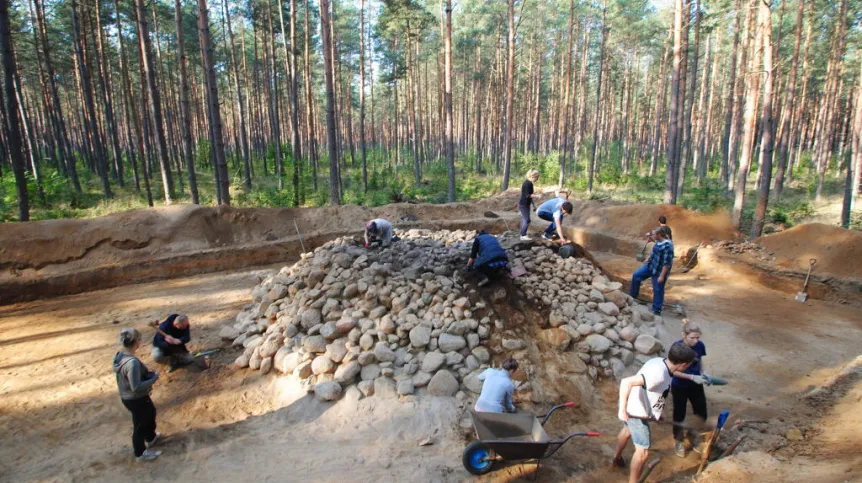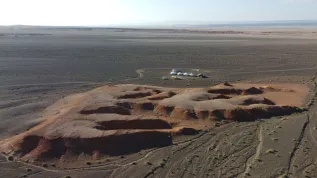
Archaeologists from the Institute of Prehistory of A. Mickiewicz University in Poznań conducted excavations of a several meters in diameter mound in Grudna (Wielkopolska), built nearly 2000 years ago. Inside they found a rich burial.
"Due to the size of the structure, the works lasted nearly two months - told PAP Igor Kołoszuk, head of the excavation. - To examine the entire structure, we removed several tons of earth and stones. Tedious and time-consuming excavation paid off, however."
The barrow was constructed according to a complex design. "This is not a randomly heaped pile of stones covered with sand" - said Kołoszuk.
The area had probably been prepared before the structure was erected. According to the researchers, necessary rituals for the purification of the place may have been performed, because at ground level, archaeologists discovered a layer of burning. There were no fragments of burned bones or other signs which might indicate that it was a remnant of funeral pyre. This layer contained the burial pit. In a small cavity the researchers discovered incinerated remains of the deceased. Among them was a large amount of fragments of ornaments made of bronze, iron and occasionally silver and gold. They numbered more than 320.
Over the grave, the ancient builders created a structure with field stones - first, two rings of larger boulders. The diameter of the larger ring was over 10 meters, and the inner oval reached 3.5 m. The surface of the inner ring was paved with smaller stones, and the space between the two rings was filled with stones to form a shaft with a height of 1.5 m, forming a "stone nest" with an oval interior. Then, whole structure was covered with sand. The resulting embankment was paved with small pebbles.
"Both the structure of the mound, as well as the wealth of burial indicate considerable social status of the buried person. The structure was the most magnificent in the cemetery, and the only one that was not robbed" - said Kołoszuk.
When Poznań archaeologists began excavations in Grudna two years ago, next to the mound and embankment they discovered a tomb, in which they found, among other things, an imported, luxury vessel with Roman stamp "P.CIPI.POLIBI" and fragments of imported fabrics. However, there were no human remains. Found traces suggested that the skeleton had been pulled from the grave, but robbery was ruled out. After a year\'s study, archaeologists offered an unusual hypothesis.
"We believe that we could have discovered traces of a specific burial ritual from before 2000 years. Perhaps the empty tomb discovered in 2012 and the cremation grave discovered contained the remains of the same person. They were located very close to each other. Perhaps the body of the person buried in the skeletal grave remained there for a time, and then was exhumed and buried again, this time in the cremation rite" - proposed Kołoszuk.
Such a reconstruction of funeral rite is probable, but difficult to prove. Archaeologists know similar examples of exhumation from the same period, that is, from the period of Roman influence. However, proving that the two graves contained dead body of the same person is not possible.
In the coming years, archaeologists together with the local forest inspectorate Lipka intend to adapt prehistoric burial site for visitors. They plan to reconstruct the largest mound, set educational path and install information boards. Historical objects collected during the study will be exhibited in the Museum of the Złotów Land.
Ancient burial ground, which consists of 10 burial mounds, was discovered in Grudna just three years ago. Unfortunately, it fell prey to robbers several times in the past. Almost all mounds bear traces of numerous robbery pits. Some mounds are completely destroyed. Archaeologists decided to examine the largest of them. Luckily, it turned out not to have been robbed.
The study was financed by the Institute of Prehistory, Adam Mickiewicz University in Poznań and Wielkopolska Provincial Conservator. Excavations took place in August and September 2014.
PAP - Science and Scholarship in Poland
szz/ agt/ mrt/
tr. RL













